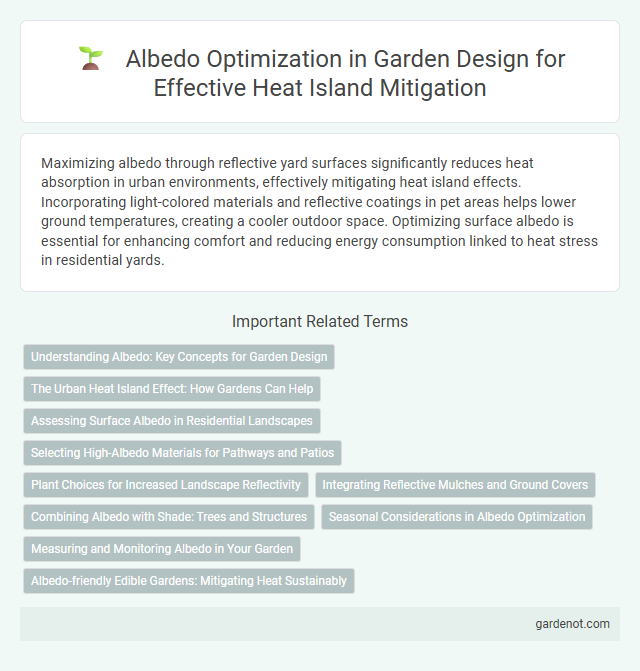Maximizing albedo through reflective yard surfaces significantly reduces heat absorption in urban environments, effectively mitigating heat island effects. Incorporating light-colored materials and reflective coatings in pet areas helps lower ground temperatures, creating a cooler outdoor space. Optimizing surface albedo is essential for enhancing comfort and reducing energy consumption linked to heat stress in residential yards.
Understanding Albedo: Key Concepts for Garden Design
Albedo optimization in garden design involves selecting materials and plants with high reflectivity to reduce surface temperatures and mitigate urban heat islands effectively. Understanding albedo values of different surfaces, such as light-colored mulch, reflective stones, and plant foliage, allows designers to maximize solar radiation reflection. Incorporating these albedo principles enhances thermal comfort and energy efficiency in residential and commercial yard spaces.
The Urban Heat Island Effect: How Gardens Can Help
Optimizing albedo in urban gardens significantly reduces the Urban Heat Island (UHI) effect by increasing surface reflectivity and lowering ambient temperatures. High-albedo plants and reflective mulches absorb less solar radiation, mitigating heat accumulation in city environments. Implementing these strategies in residential and public green spaces enhances cooling efficiency and improves urban microclimates.
Assessing Surface Albedo in Residential Landscapes
Assessing surface albedo in residential landscapes involves measuring the reflectivity of materials like roofing, pavements, and vegetation to identify areas that contribute to urban heat islands. High-albedo surfaces can significantly reduce heat absorption, lowering ambient temperatures and improving thermal comfort. Implementing albedo optimization strategies in yard design helps mitigate heat island effects and enhances energy efficiency in residential areas.
Selecting High-Albedo Materials for Pathways and Patios
Selecting high-albedo materials for pathways and patios significantly reduces surface temperatures by reflecting more solar radiation, which helps mitigate urban heat island effects. Materials such as light-colored concrete, reflective pavers, and cool pavements increase albedo values, enhancing thermal comfort and lowering surrounding air temperatures. Incorporating these surfaces in heat island mitigation yards supports energy savings by reducing the need for artificial cooling.
Plant Choices for Increased Landscape Reflectivity
Selecting high-albedo plants such as light-colored grasses, succulents, and silver-leafed shrubs significantly enhances landscape reflectivity, reducing heat absorption in urban yards. These plants reflect more solar radiation compared to darker foliage, directly mitigating the urban heat island effect by lowering surface and ambient temperatures. Incorporating drought-tolerant species with reflective leaves sustains albedo optimization while supporting water conservation efforts.
Integrating Reflective Mulches and Ground Covers
Integrating reflective mulches and ground covers significantly enhances albedo optimization by increasing surface reflectivity, reducing heat absorption in urban yards. Reflective materials with high solar reflectance can lower local temperatures by reflecting solar radiation back into the atmosphere. This method effectively mitigates urban heat island effects by maintaining cooler soil and ambient air temperatures around residential and commercial green spaces.
Combining Albedo with Shade: Trees and Structures
Combining high-albedo surfaces with strategically placed trees and shade structures significantly reduces heat island effects by reflecting solar radiation and providing cooling through shading. Trees enhance albedo benefits by intercepting sunlight, lowering surface temperatures, and improving microclimate conditions in urban yards. Incorporating reflective materials alongside green infrastructure maximizes energy savings and mitigates thermal stress in built environments.
Seasonal Considerations in Albedo Optimization
Seasonal considerations in albedo optimization are crucial for effective heat island mitigation, as surface reflectivity impacts vary with sun angle and weather conditions throughout the year. High-albedo materials should be selected to maximize solar reflectance during summer months when heat absorption peaks, while balancing winter warming needs to avoid excessive heat loss. Incorporating region-specific climate data and seasonal solar intensity patterns enhances the efficiency of albedo-targeted interventions in urban yards.
Measuring and Monitoring Albedo in Your Garden
Measuring and monitoring albedo in your garden is essential for effective heat island mitigation, as higher surface reflectance reduces heat absorption. Use albedometers or portable reflectance meters to obtain accurate albedo values of various garden surfaces, such as soil, mulch, and plants. Regular monitoring helps optimize material choices and layout adjustments to enhance overall garden albedo and minimize local temperature increases.
Albedo-friendly Edible Gardens: Mitigating Heat Sustainably
Albedo-friendly edible gardens increase surface reflectivity by incorporating light-colored, reflective plants and materials that reduce heat absorption in urban yards. These gardens not only lower surrounding temperatures by enhancing the albedo effect but also support sustainable food production, improving local microclimates. Implementing reflective mulch and pale foliage varieties strategically boosts albedo while promoting biodiversity and resilience against urban heat islands.
Albedo optimization Infographic

 gardenot.com
gardenot.com